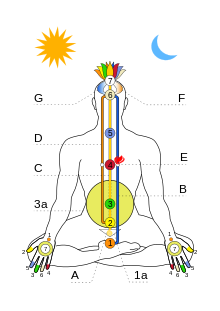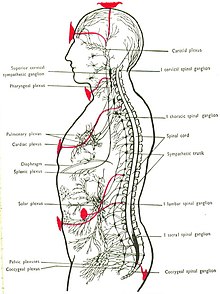Nadi (yoga)
With Nadi ( Sanskrit , नाडि, Nadi channel tube) are in Yoga and Tantra subtle energy channels called that run through the body with prana (vital energy) supply (similar to the principle of meridians in traditional Chinese medicine ). The term nadi is probably derived from the root nad = movement, drive, vibration.
In the old scriptures there are different statements about the number of nadis. The Shivasamhita speaks of 350,000 nadis, the Hatha Yoga Pradipika (approx. 1500 AD) mentions 72,000 nadis. In yoga practice, however, the three main channels, called Sushumna , Ida and Pingala , are primarily important. Most nadis originate in the area on the pelvic floor called the "kanda" .
Some theories assume that Ida arises on the right side, on the left of the spine runs to the left nostril, and accordingly pingala arises on the left side, on the right of the spine runs to the right nostril. According to other theories, they spiral and cross at the level of the chakras . According to yoga teaching, Ida is assigned to the female principle (qualities: cooling, calming) and Pingala is assigned to the male principle (qualities: heating, stimulating).


It is irrelevant whether the concept of chakras , nadis is exclusively esoterically derived from the coherent system of tantras or whether there can or will actually be evidence based on empirical-scientific thinking, in the sense that they can be physically found, What is decisive is that they can be experienced and effective in meditative practice or the healing ritual through imagination .
The Granthis , these are energy blockages in Sushumna, which block the rising of energies, including Kundalini, play an important role.
literature
- Professional association of yoga teachers in Germany (ed.): The way of yoga. Publisher Via Nova
Individual evidence
- ^ CW Leadbeater: The Chakras. Quest Books, 2013, ISBN 978-0-8356-0912-8
- ↑ Kundalini and the subtle system of the body. Text excerpt from Karin Brucker: The elemental force Kundalini: Recognize phenomena, interpret symptoms, master transformation. OW Barth, Munich 2011, ISBN 978-3-4264-1037-0 , accessed October 13, 2018 [1]